
Talenkauen is a genus of basal iguanodont dinosaur from the Campanian or Maastrichtian age of the Late Cretaceous Cerro Fortaleza Formation, formerly known as the Pari Aike Formation of Patagonian Lake Viedma, in the Austral Basin of Santa Cruz, Argentina. It is based on MPM-10001A, a partial articulated skeleton missing the rear part of the skull, the tail, and the hands. The type and only species is Talenkauen santacrucensis.
The Bajo de la Carpa Formation is a geologic formation of the Neuquén Basin that crops out in northern Patagonia, in the provinces of Río Negro and Neuquén, Argentina. It is the oldest of two formations belonging to the Río Colorado Subgroup within the Neuquén Group. Formerly, that subgroup was treated as a formation, and the Bajo de la Carpa Formation was known as the Bajo de la Carpa Member.

The Anacleto Formation is a geologic formation with outcrops in the Argentine Patagonian provinces of Mendoza, Río Negro, and Neuquén. It is the youngest formation within the Neuquén Group and belongs to the Río Colorado Subgroup. Formerly that subgroup was treated as a formation, and the Anacleto Formation was known as the Anacleto Member.

Orkoraptor is a genus of medium-sized megaraptoran theropod dinosaur from the late Cretaceous Period of Argentina. It is known from incomplete fossil remains including parts of the skull, teeth, tail vertebrae, and a partial tibia. The specialized teeth resemble those of some maniraptoriform theropods, namely the deinonychosaurs and compsognathids. This and other anatomical features led the authors who described it to suggest that it was a maniraptoran coelurosaur. However, subsequent studies found it to be a megaraptoran. Found in the Cerro Fortaleza Formation of Southern Patagonia, it is one of the southernmost carnivorous dinosaurs known from South America.
The Magallanes Basin or Austral Basin is a major sedimentary basin in southern Patagonia. The basin covers a surface of about 170,000 to 200,000 square kilometres and has a NNW-SSE oriented shape. The basin is bounded to the west by the Andes mountains and is separated from the Malvinas Basin to the east by the Río Chico-Dungeness High. The basin evolved from being an extensional back-arc basin in the Mesozoic to being a compressional foreland basin in the Cenozoic. Rocks within the basin are Jurassic in age and include the Cerro Toro Formation. Three ages of the SALMA classification are defined in the basin; the Early Miocene Santacrucian from the Santa Cruz Formation and Friasian from the Río Frías Formation and the Pleistocene Ensenadan from the La Ensenada Formation.

The La Colonia Formation is a geological formation in Argentina whose strata date back to the Late Cretaceous. Dinosaur remains are among the fossils that have been recovered from the formation.

The Allen Formation is a geological formation in Argentina whose strata date back to the Late Cretaceous (middle Campanian to early Maastrichtian. Dinosaur remains are among the fossils that have been recovered from the formation. Indeterminate chelid remains and other vertebrates have also been discovered in this formation.
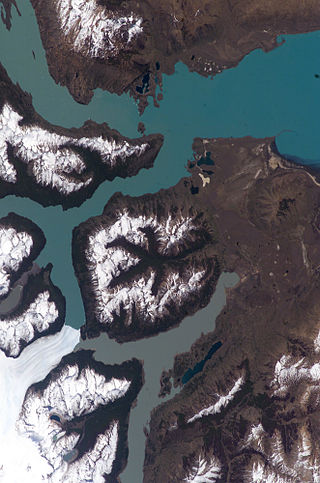
The Chorrillo Formation, also named as Chorillo Formation, is a Maastrichtian geologic formation in southern Patagonia, Argentina. The formation is more than 50 metres (160 ft) thick and underlies the Calafate Formation and rests on top of the La Irene Formation.

Austrocheirus is an extinct genus of theropod dinosaur that lived during the Late Cretaceous period. It was named and described by Martin Ezcurra, Federico Agnolin and Fernando Novas in 2010. It contains the type species Austrocheirus isasii. The generic name means "southern hand". The specific epithet honours discoverer and preparator Marcelo Pablo Isasi.
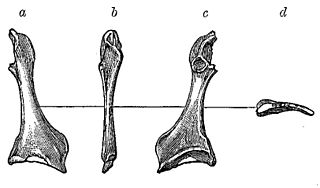
Cimolopterygidae is an extinct family of ornithurine dinosaurs known from the Late Cretaceous epoch. Remains attributed to cimolopterygids have been found in the Frenchman Formation of Saskatchewan, the Lance Formation of Wyoming, the Fox Hills Formation of Colorado, the Hell Creek Formation of Montana, and the Allen Formation of Rio Negro, Argentina. Most date to the end of the Maastrichtian age, about 66 million years ago, though a much earlier species has also been identified from the Campanian-aged Dinosaur Park Formation of Alberta, about 75 million years ago.
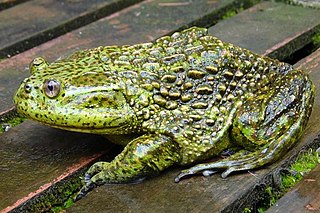
The Calyptocephalellidae are a family of toads found in Chile containing two living genera, Calyptocephalella and Telmatobufo.

The Mata Amarilla Formation is a fossiliferous formation of the Austral Basin in southern Patagonia, Argentina. The formation consists of sediments deposited during the Middle Cenomanian, dated to 96.94 to 95.52 Ma. The middle section of the formation was previously considered to be the Pari Aike Formation.
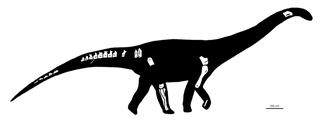
Nullotitan is a genus of lithostrotian titanosaur from the Chorrillo Formation from Santa Cruz Province in Argentina. The type and only species is Nullotitan glaciaris. It was a contemporary of the ornithopod Isasicursor which was described in the same paper.

Maip is a genus of large megaraptorid theropod dinosaur from the Late Cretaceous (Maastrichtian) Chorrillo Formation of Santa Cruz, Argentina. The genus contains a single species, M. macrothorax, known from an incomplete, disarticulated skeleton. Maip may represent the largest megaraptorid known from South America, and possibly the world.
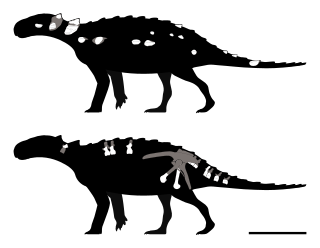
Patagopelta is an extinct genus of ankylosaurian dinosaur from the Late Cretaceous Allen Formation of Argentina. The genus contains a single species, P. cristata, known from a partial skeleton. While originally described as a nodosaurine, later discoveries provided support for parankylosaurian affinities for the taxon. Patagopelta is a very small ankylosaur, comparable in size to the dwarf nodosaurid Struthiosaurus, about 2 m (6.6 ft) long.

Yatenavis is an extinct genus of enantiornithine bird from the Late Cretaceous Chorrillo Formation of Santa Cruz Province, Argentina. The genus contains a single species, Y. ieujensis, known from a partial humerus.

Patagorhynchus is a genus of prehistoric monotreme mammal from the Late Cretaceous Chorrillo Formation of Santa Cruz Province, Argentina. The genus contains a single species, Patagorhynchus pascuali. The holotype, MPM-PV-23087, consists of a lower right molar attached to a fragment of the dentary. It was collected near Rio Gallegos, Santa Cruz, Argentina in 2022 and is housed in the Museo Padre Molina.

Titanomachya is an extinct genus of titanosaurian sauropod dinosaur from the Late Cretaceous La Colonia Formation of Argentina. The genus contains a single species, T. gimenezi. It is a relatively small titanosaur, weighing around 7.8 tonnes.
Koleken is a genus of carnotaurin abelisaurid from the Maastrichtian La Colonia Formation in the Chubut Province of Argentina. The type and only species is K. inakayali, known from one immature specimen about six years old in minimum age.















